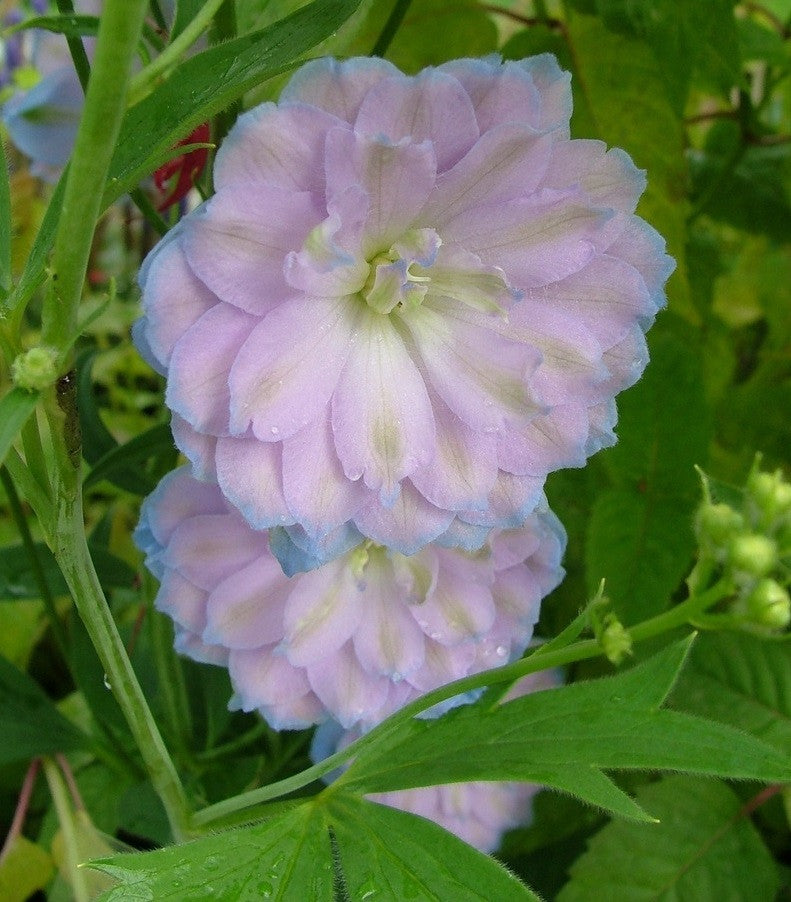Delphinium 'Misty Mauves' (New Millennium Series) (d)
Approx. 0.5 litre pot
About this cultivar:
Delphinium 'Misty Mauves' (New Millennium Series) (d) is a new-ish introduction from Terry Dowdeswell in New Zealand. It has frilly, nearly double flowers in a range of colors from dark purple to mauve. More compact that other Delphiniums, the compact-clustered nature of flowers on the flower-spikes really stands out - almost like a blue Kniphofia! The rough foliage also looks good. Forsuch an old garden genus its amazing new cultivars still surprise!
- Position: Full sun, partial shade
- Soil: Almost any soil, grows well in Ballyrobert
- Flowers: June, July
- Other features: Grows well in Ballyrobert, Bees and Butterflies
- Hardiness: Fully hardy, grows well in Ballyrobert
- Habit: Columnar or Upright, clump forming
- Foliage: Deciduous
- Height: 90 - 120 cm (3 - 4 ft)
- Spread: 60 - 120 cm (2 - 4 ft)
- Time to full growth: 2 to 5 years
- Plant type: Herbaceous Perennial
- Colour: Green, purple
- Goes well with: Achillea, Geranium, Campanula, Aconitum
About this genus:
Delphinium is a large genus of about 300 species of perennial flowering plants in the buttercup family (Ranunculaceae) native throughout the Northern Hemisphere. Delphinium is taken from the the Greek word delphinion, derived from delphinos or delphis for "dolphin" thought to be so named because of the similarity of the opening flower. The common name dates back to Tudor England when some of the species grown were referred to as Larkspur and occasionally Lark's Heel (from Shakespeare), Lark's Claw, and Knight's Spur, apparently because the nectar sepal looked somewhat akin to a lark's claw.
The history of the cultivated Delphiniums is old. As early as 1778 Delphinium species were being sold. Other species were rapidly introduced and by the middle of the 19th century hybridisation was being carried on by a number of French growers, chief among whom was Victor Lemoine, originator of most of the first varieties of perennial garden Delphiniums.
Often though of as a traditional cottage garden plant, in reality Delphinium can brighten up any type of garden. This because when they flower through June, July, and August they can add a vertical presence in a range of colours. These plants still have a reputation for being difficult to grow despite being popular in gardens over hundreds of years. We have tried many many cultivars in our garden at Ballyrobert and have selected our best performers for sale.
Delphiniums prefer sun or part shade. The books will tell you to treat them with all sorts of kitchen remedies, fertilizer, mulch, prayers, and what not. Don't bother - we don't. The cultivars we sell should be fine almost anywhere as long as they are not waterlogged or in full shade. They shouldn't need staked either unless the weather makes them grow faster than usual.
Try them with Achillea, Geranium, Campanula, and Aconitum - or even in swathes with other Delphinium (they are native so have a nice wildflower look)




